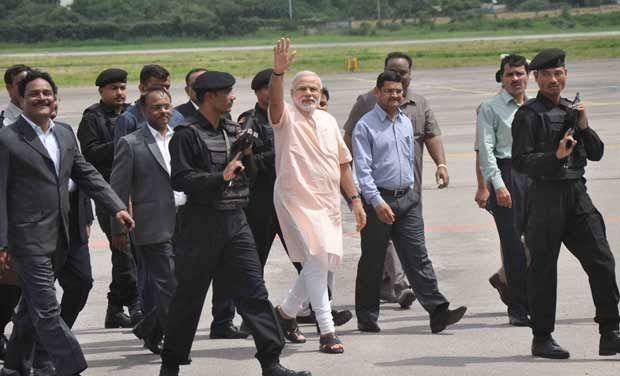
New Delhi: The dress allowance given to diplomats and elite Special Protection Group (SPG) officers, entrusted with the security of Prime Minister Narendra Modi, former prime ministers and their families, have been hiked considerably.
The move comes on the recommendation of the Seventh Central Pay Commission.
SPG officers during operational duties would get Rs 27,800 annually and on non-operational work would get Rs 21,225 a year as dress allowance, according to an official order.
Before the implementation of the panel’s recommendation, the officers were getting Rs 9,000 annually as uniform allowance.
The SPG guards Modi, former prime minister Manmohan Singh, Congress chief Sonia Gandhi, her children Rahul and Priyanka, among others.
The pay commission had in its report recommended an annual grant of Rs 10,000 as dress allowance. The panel’s report was examined by a Committee on Allowances headed by Finance Secretary Ashok Lavasa.
The Seventh Central Pay Commission examined 196 allowances given to various categories of central government employees.
“Outfit allowance, paid to Indian Foreign Service (IFS) officers and employees will continue to be provided as before, is enhanced by 50 per cent,” the order issued recently by the finance ministry said.
The IFS officers were getting Rs 5,625 to Rs 10,625 per posting abroad, depending on their grade, as uniform allowance.
The uniform allowance given to all categories of employees was recommended to be abolished as a separate grant by the pay commission, that had recommended it is subsumed in the newly-proposed dress allowance.
Officers of the Indian Army, Air Force, Navy, central armed police forces, central police organisations and coast guards would get a dress allowance of Rs 20,000 per year.
Except for the Navy and the Coast Guard, other officers were getting an initial annual allowance of Rs 21,000 and a renewal grant of Rs 4,500 (payable every three years).
Those in the Navy and the Coast Guard were entitled for an initial grant of Rs 24,000 and then Rs 7,500 (payable every three years).
Military Nursing Service officers and those in Delhi, Andaman and Nicobar Islands, Lakshadweep, Daman and Diu and Dadra and Nagar Haveli Police Service (DANIPS) would get Rs 15,000 annually as dress allowance.
The MNS and the DANIPS officers were getting initial grants of Rs 10,500 and Rs 7,200 respectively. They were also entitled for renewal grants of Rs 2,250 and Rs 3,000 respectively (payable every three years).
Executive staff of customs, Indian Corporate Law Service officers, legal officers in National Investigation Agency, Bureau of Immigration personnel in Mumbai, Chennai, Delhi, Amritsar, Kolkata and all other foreigners entry checkpoints, among others, would get Rs 10,000 every year as the dress allowance.
These were getting initial grants between Rs 1,500 and Rs 2,000 and then replacement grants between Rs 1,000 and Rs 1,250 per annum, depending on their post.
Other categories of staff who were supplied uniforms and were required to wear them regularly like trackmen, running staff of the Indian Railways and staff car drivers among others would get Rs 5,000 annually.
Nurses would get Rs 1,800 per month as the dress allowance. They were getting Rs 750 per month.
Allowances related to maintenance, washing of uniform are subsumed in dress allowance and will not be payable separately, it said.
“The amount of dress allowance shall be credited to the salary of employees directly once a year in the month of July,” the order said, adding that the new charges take effect from July 1, 2017.
The rates of dress allowance would go up by 25 per cent each time the Dearness Allowance rises by 50 per cent.
The clothing allowance,
kit maintenance allowance, washing allowance, robe allowance, robe maintenance allowance, outfit allowance, shoe allowance and uniform allowance given to select categories of employees were recommended by the pay panel to be abolished as a separate grant, and be subsumed in the dress allowance.


.jpeg)

